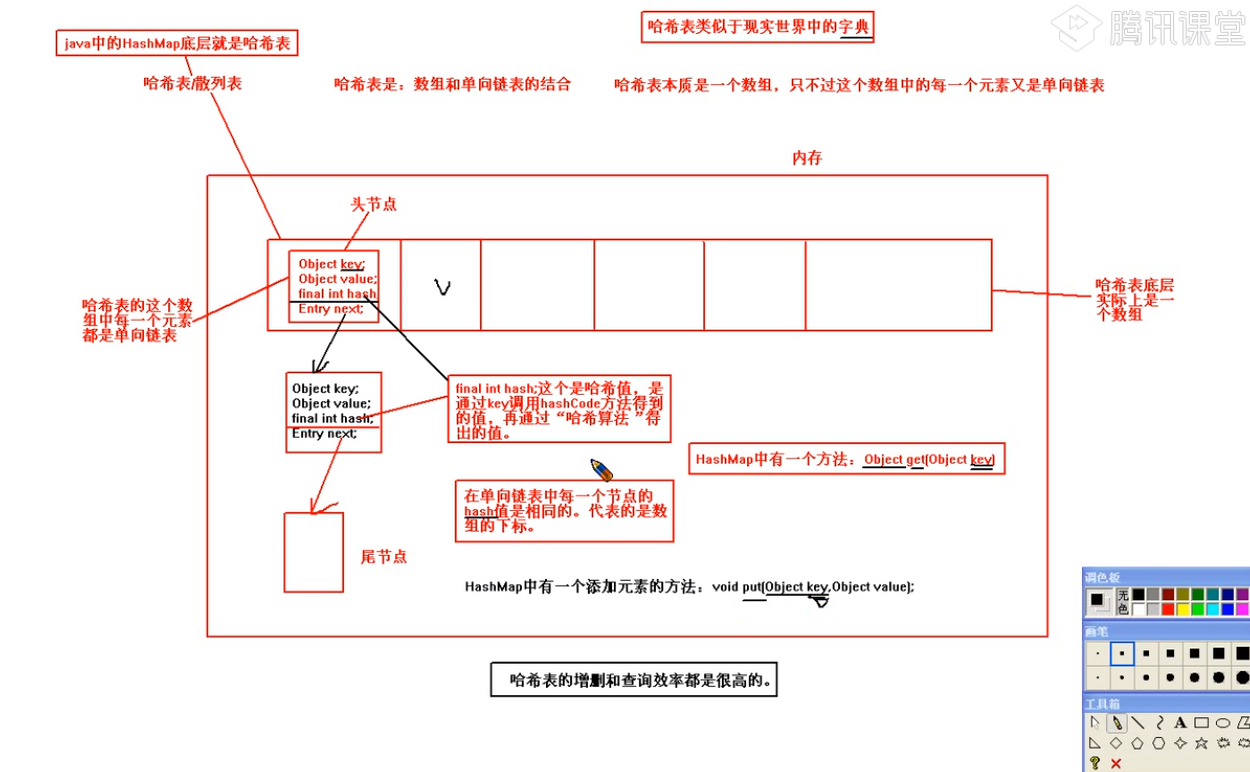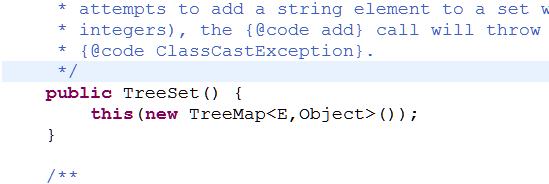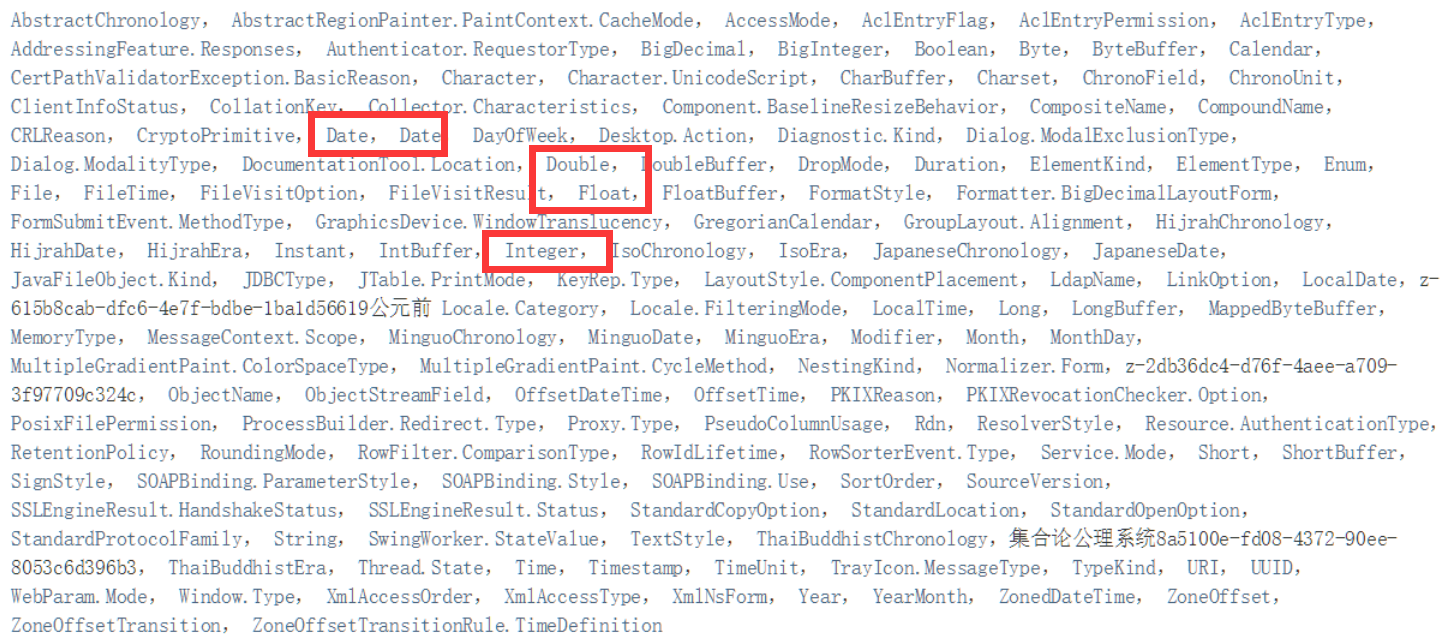什么是HashSet?操作过程是怎么样的?
1、HashSet底层实际上是一个HashMap,HashMap底层采用了哈希表数据结构
2、哈希表又叫做散列表,哈希表底层是一个数组,这个数组中每一个元素是一个单向链表,每个单向链表都有一个独一无二的hash值,代表数组的下标。在某个单向链表中的每一个节点上的hash值是相同的。hash值实际上是key调用hashCode方法,再通过"hash function"转换成的值
3、如何向哈希表中添加元素?
先调用被存储的key的hashCode方法,经过某个算法得出hash值,如果在这个哈希表中不存在这个hash值,则直接加入元素。如果该hash值已经存在,继续 调用Key之间的equals方法,如果equals方法返回false,则将该元素添加。如果equals方法返回true,则放弃添加该元素
HashMap和HashSet初始化容量是16,默认加载因子是0.75
HashSet的数据结构
献上我看视频截的图

代码举例
1 public class Test{ 2 3 public static void main(String[] args) { 4 5 Set set = new HashSet(); 6 7 Student stu1 = new Student("1", "JACK"); 8 Student stu2 = new Student("2", "TOM"); 9 Student stu3 = new Student("3", "JIM"); 10 11 set.add(stu1); 12 set.add(stu2); 13 set.add(stu3); 14 15 System.out.println("size :" + set.size()); 16 } 17 18 19 20 } 21 22 class Student{ 23 String no; 24 String name; 25 26 Student(String no, String name){ 27 this.no = no; 28 this.name = name; 29 } 30 }
这个的输出结果显而易见是3,因为我们添加了三个元素,但是如果改一下
1 Student stu1 = new Student("1", "JACK"); 2 Student stu2 = new Student("1", "JACK"); 3 Student stu3 = new Student("3", "JIM"); 4 5 System.out.println(stu1.hashCode()); 6 System.out.println(stu2.hashCode());
可以运行试一下,stu1和stu2的hashCode是不一样的,为什么呢?因为这两个对象是New出来的,引用地址不一样。我们不希望出现这样的情况,那就要重写hashCode和equals方法
1 class Student{ 2 String no; 3 String name; 4 5 Student(String no, String name){ 6 this.no = no; 7 this.name = name; 8 } 9 10 public boolean equals(Object o){ 11 if(this == o) return true; 12 if(o instanceof Student){ 13 Student student = (Student) o; 14 if(student.no.equals(this.no) && student.name.equals(this.name)) return true; 15 } 16 17 return false; 18 } 19 20 public int hashCode(){ 21 return no.hashCode(); 22 } 23 }
再次运行,插入两个数据一样的对象,就不会重复了
TreeSet
treeset实现了sortedset接口,有个很重要的特点是里面的元素都是有序的
1 public class Test{ 2 3 public static void main(String[] args) { 4 5 SortedSet set = new TreeSet(); 6 7 set.add(1); 8 set.add(100); 9 set.add(50); 10 11 System.out.println(set); 12 } 13 14 }
输出结果:[1, 50, 100]
那如果我们自定义类可以进行比较吗?
1 public class Test{ 2 3 public static void main(String[] args) { 4 5 SortedSet set = new TreeSet(); 6 7 Student stu1 = new Student(22); 8 Student stu2 = new Student(11); 9 Student stu3 = new Student(100); 10 11 set.add(stu1); 12 set.add(stu2); 13 set.add(stu3); 14 15 System.out.println(set); 16 } 17 18 } 19 20 class Student{ 21 int age; 22 23 Student(int age){ 24 this.age = age; 25 } 26 }
这样运行会出现一个问题,报ClassCastException,这就需要来看看源码了,底层到底是怎么实现的,为什么自定义类就先不行呢?

这里可以看到,当我们在创建一个TreeSet的时候,实际上是new了一个TreeMap

add的时候调用了TreeMap的put方法,来看看TreeMap中的put方法

可以看到第三个红框那里,会对key进行一个强制类型转换,我们上面的代码肯定是就是在这里装换不成功,Comparable是什么?来看看API

是一个接口,从翻译就可以看出,只要实现了这个接口,就是可以比较的,下面是实现了这个接口的类

随便框了几个,上面就有Integer,这个类实现了comparable接口,因此第一个代码是正确的,现在我们是不是只要实现这个接口就好了呢!
1 class Student implements Comparable{ 2 int age; 3 4 Student(int age){ 5 this.age = age; 6 } 7 8 //重写接口中的方法 9 //要重写比较规则 10 @Override 11 public int compareTo(Object o) { 12 // TODO Auto-generated method stub 13 int age1 = this.age; 14 int age2 = ((Student)o).age; 15 return age2 - age1; 16 } 17 }
这样OK了,再来看看上面有红框的源码,cmp<0,cmp>0,left,right都是什么东西,二叉树!所以底层是通过二叉树来排序的
如果是自定义类中的String呢,那就return String的compareTo方法就好了